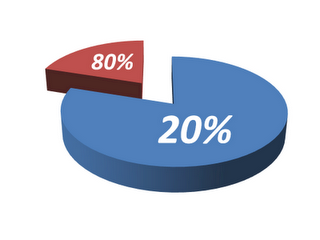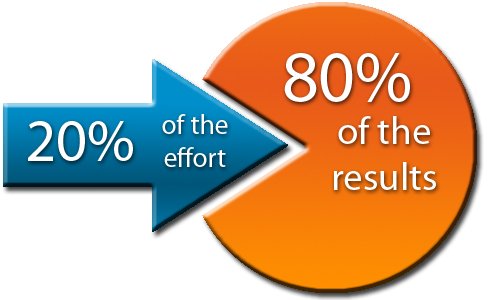The Pareto principle
The Pareto principle is a principle is an interesting phenomena that spans many aspects of life. Things like language, computer programming, economics, sports, science and many more.

What is the 80-20 rule?
The 80-20 rule, or Pareto principle, states that for many events, about 80% of the effects are a result of 20% of the causes. The rule comes from Joseph M. Juran, who named it after an Italian economist names Vilfredo Pareto. Pareto first wrote about the phenomena in 1896 when he showed in his published paper, "Cours d'ecconomei politique", that about 80% of the land owned in Italy was owned by only 20% of the population. The principal was first developed by him when he came to the conclusion that 80% of the peas he harvested in his garden only came from 20% of the pea pods.

During Pareto's exploration of the 80-20 rule, he surveyed many other countries from all over the world. He found that in many of the countries that he surveyed, he found that about 80% of land was owned by 20% of the population. This distribution was further looked into in 1992 with the United Nations Development program report, and it showed that the income of people all around the world was stunningly uneven. With 20% of the world population having control of 82.7% of the income world wide.
For the Distribution of world GDP in 1989,
Richest 20% had 82.7% income
the second 20% had 11.75% income
the third 20% had 2.3% income
the fourth 20% had 1.85% income
and the poorest 20% had 1.4% income.
80-20 in software

The 80-20 rule also exists very noticeable in the computer science industry. In one example, the software giant, Microsoft saw that when 20% of the most reported software bugs were fixed, 80% of the errors that were related to the ones fixed were also fixed. This can also be reinforced by the statement from Lowell Arthur, a software engineer, who said that 80% of the errors in a code only come from 20% of the actual coding.
80-20 in business
In business the 80-20 rule is very prominent. Examples that support the rule are: 80% of problems come from 20% of cause, 80% of sales are made by just 20% of the sales staff, 80% of profit comes from 20% of the time the staff spent trying to make money, and so on.
This rule allows for businesses to make easy and large improvements upon profit by fixing just a few of the issues and leaving the others as are because they make little difference either way.
Misuse of the 80-20 rule
The 80-20 rule is useful in many areas of research, especially in mathematics. It is often misuses though. It is often missuses when 80% of cases fit the rule and the assumption is made that the rule fits the situation. It is also wrong when the rules used to analyze data sets that aren't very big.
Sources:
www.entrepreneurs-journey.com/397/80-20-rule-pareto-principle/
www2.latech.edu/~box/ase/papers2011/Ankunda_termpaper.PDF
web.archive.org/web/20130128204020/
www.80-20presentationrule.com/whatisrule.html
www.vacationrentalmarketingblog.com/wp-content/uploads/2012/12/80-20.png